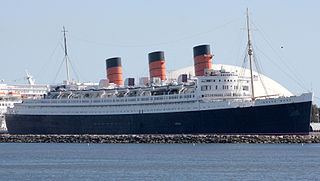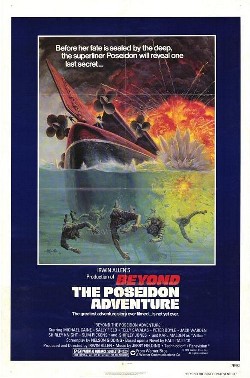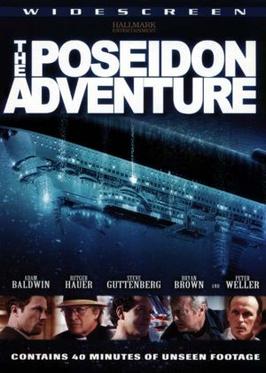
RMS Queen Elizabeth was an ocean liner operated by Cunard Line. In tandem with Queen Mary both ships provided a weekly luxury liner service between Southampton in the United Kingdom and New York City in the United States, via Cherbourg in France.

RMS Queen Mary is a retired British ocean liner that sailed primarily on the North Atlantic Ocean from 1936 to 1967 for the Cunard Line and was built by John Brown & Company in Clydebank, Scotland. Queen Mary, along with RMS Queen Elizabeth, was built as part of Cunard's planned two-ship weekly express service between Southampton, Cherbourg and New York. The two ships were a British response to the express superliners built by German, Italian and French companies in the late 1920s and early 1930s.

An ocean liner is a type of passenger ship primarily used for transportation across seas or oceans. Ocean liners may also carry cargo or mail, and may sometimes be used for other purposes. Only one ocean liner remains in service today.

SS Andrea Doria was a luxury transatlantic ocean liner of the Italian Line, put into service in 1953. She is widely known from the extensive media coverage of her sinking in 1956, which included the remarkably successful rescue of 1,660 of her 1,706 passengers and crew.

A passenger ship is a merchant ship whose primary function is to carry passengers on the sea. The category does not include cargo vessels which have accommodations for limited numbers of passengers, such as the ubiquitous twelve-passenger freighters once common on the seas in which the transport of passengers is secondary to the carriage of freight. The type does however include many classes of ships designed to transport substantial numbers of passengers as well as freight. Indeed, until recently virtually all ocean liners were able to transport mail, package freight and express, and other cargo in addition to passenger luggage, and were equipped with cargo holds and derricks, kingposts, or other cargo-handling gear for that purpose. Only in more recent ocean liners and in virtually all cruise ships has this cargo capacity been eliminated.

The Poseidon Adventure is a 1972 American disaster film directed by Ronald Neame, produced by Irwin Allen, and based on Paul Gallico's 1969 novel of the same name. It has an ensemble cast including five Oscar winners: Gene Hackman, Ernest Borgnine, Jack Albertson, Shelley Winters, and Red Buttons. The plot centers on the fictional SS Poseidon, an aging luxury liner on her final voyage from New York City to Athens, before it is scrapped. On New Year's Day, it is overturned by a tsunami. Passengers and crew are trapped inside, and a preacher attempts to lead a small group of survivors to safety.
Poseidon is the god of the sea in ancient Greek mythology.

Poseidon is a 2006 American action disaster film directed and co-produced by Wolfgang Petersen. It is the third film adaptation of Paul Gallico's 1969 novel The Poseidon Adventure, and a loose remake of the 1972 film. It stars Kurt Russell, Josh Lucas and Richard Dreyfuss with Emmy Rossum, Jacinda Barrett, Mike Vogel, Mía Maestro, Jimmy Bennett and Andre Braugher in supporting roles. It was produced and distributed by Warner Bros. in association with Virtual Studios. It had a simultaneous release in IMAX format. It was released on May 12, 2006, and it was criticized for its script but was praised for its visuals and was nominated at the 79th Academy Awards for Best Visual Effects. It grossed $181.7 million worldwide on a budget of $160 million; however, after the costs of promotion and distribution, Warner Bros. lost $70–80 million on the film, making it a box-office bomb as a result.

Beyond the Poseidon Adventure is a 1979 American disaster film and a sequel to The Poseidon Adventure (1972) directed by Irwin Allen and starring Michael Caine and Sally Field. It was a critical and commercial failure, and was the only Allen disaster film to receive no Academy Award nominations. Its box office receipts were only 20% of its estimated $10 million budget.

The legendary island of Atlantis has often been depicted in literature, television shows, films and works of popular culture.

Futility is a novella written by Morgan Robertson, first published in 1898. It was revised as The Wreck of the Titan in 1912. It features a fictional British ocean liner named Titan that sinks in the North Atlantic Ocean after striking an iceberg. The Titan and its sinking are famous for similarities to the passenger ship RMS Titanic and its sinking 14 years later. After the sinking of the Titanic the novel was reissued with some changes, particularly to the ship's displacement.

The Poseidon Adventure is an American adventure novel by Paul Gallico, published in 1969. It concerns the capsizing of a luxurious ocean liner, the S.S. Poseidon, due to an undersea earthquake that causes a 90-foot (27-meter) wave, and the desperate struggles of a handful of survivors to reach the bottom of the liner's hull before the ship sinks.

The Poseidon Adventure is a 2005 American made-for-television disaster film based on Paul Gallico's 1969 novel of the same name. It is a loose remake of the 1972 film of the same name and its 1979 sequel.

Atlantic (1929) is an all-talking sound British drama film directed and produced by Ewald André Dupont and starring Franklin Dyall and Madeleine Carroll. Originally, two versions were made, the English and German-language version Atlantik were shot simultaneously. Subsequently, the production of a French version (Atlantis) began in spring 1930 using different footage and partially an altered storyline with a different director. The fourth version was released as a silent film. The story was taken from the West End play The Berg by Ernest Raymond. It was one of the most expensive films of 1929.
Goliath Awaits is a 1981 American made-for-television action adventure science fiction thriller film originally broadcast in two parts in November 1981 on various stations as a part of Operation Prime Time's syndicated programming. It is about an ocean liner sunk by a German U-boat in 1939 whose wreck is discovered in 1981, with over 300 survivors and their descendants living in an air bubble inside the ship.

RMS Queen Mary 2 (QM2) is a British transatlantic ocean liner. She has served as the flagship of Cunard Line since succeeding Queen Elizabeth 2 in 2004. The ship was officially named Queen Mary 2 by Queen Elizabeth II in 2004 after the first RMS Queen Mary of 1936. With the retirement of Queen Elizabeth 2 in 2008, Queen Mary 2 is the only ocean liner in service in the world. It has a regular service between Southampton, England, and New York City, United States, and an annual world cruise.

Titanic II is a 2010 American drama disaster film written, directed by and starring Shane Van Dyke and distributed by The Asylum. Despite the title, it is not a sequel to the 1997 critically acclaimed film, but is a mockbuster of it. It was released direct-to-TV in Australia on 7 August 2010. It premiered on Syfy, on Sky in the UK and Ireland on 9 August. It was released on 25 August in the United States to critically negative response, though the film's ensemble cast performances, particularly that of Bruce Davison, received praise.

There have been several legends and myths surrounding the RMS Titanic and its destruction after colliding with an iceberg in the Atlantic Ocean. These have ranged from stories involving the myth about the ship having been described as "unsinkable" to the myth concerning the final song played by the ship's musicians.
















